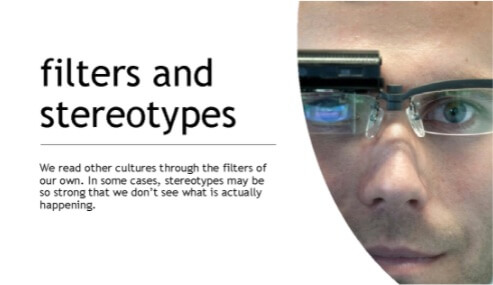National culture
National cultural identity is one group identity we have among many, but it is special because we do not opt into it; we get born into it. Imagine a world where you get to choose your native culture: a culture shop. You’re brought up in a kind of United Nations orphanage and exposed to the cultures of the planet. Then you get to pick and choose in a culture shop:
‘I quite fancy being German, but it’s maybe a bit too rigid for me. ‘
‘Well, have you thought about Bavarian, you get a lot of the traditional virtues but with a strong blend of humour and unpredictability? Then again, there’s Swiss Italian, or if you’re looking further afield, ainu Japanese.’
But of course, it doesn’t work like that. Someone else (almost certainly your ancestors) chose your culture for you. Your national identity is always there but it is not usually switched on. International meetings do not always switch it on, but they can. Once fired up it is powerful because it works on pride and divides the world into ‘them’ and ‘us.’ If you come over as arrogant or you play the ‘not invented here’ card, or say or do anything that belittles your counterpart’s national culture, you will switch it on: around the table, the team member will log out and the citizens will log in. Collaboration will suffer because national cultures are based on shared pride – success stories that we live vicariously like football supporters who don’t get to kick the ball but do get to cheer when their team wins and do feel a part of the silverware in the trophy case.
You don’t only need to understand their culture, you need to understand yours
If you stay in your own culture, it’s difficult to know much about it: you are part of it without quite knowing what you’re a part of. When you work internationally, you become very conscious of cultural difference, but you tend to see it in terms of the other culture rather than your own. This is an issue that most of us have working across cultures. We try to understand their culture without understanding our own. We see what the other person is doing, but we don’t see what we are doing, and we don’t recognize our contribution to what’s happening.
Real cultures, virtual cultures, and Zoom
Corporate culture in big companies is a common denominator across geographies, generations, and job: broad but not deep. This kind of identity is thin – the more inclusive it is, the less rich it is in know-how. Proximity makes real teams work better than virtual ones and breaks down silos because close colleagues get to spend time together and distant colleagues don’t. In informal moments and in informal places people exchange ideas that prepare the ground for future decisions and projects. They develop mutual understanding and empathy. They break down the heavy lifting of persuasion and influence into small packages that can be delivered bit by bit. They drip water onto stone until the stone becomes a channel. This kind of deep identity requires proximity and shared time.
International colleagues often have neither proximity or time: they find it difficult to create context and are forced do heavy lifting in short, concentrated sessions. Paradoxically the focus and concentration of their exchanges makes them slower. They are often frustrated at what the other doesn’t know and find that they can take nothing for granted. They need to explain everything in detail, and often have a sense that the other is obtuse. They are in danger of underestimating each other precisely because of this: sometimes it feels like talking to a child.
Cultural DNA
Cultures are living things; they have DNA. They grow without a plan or a planner. They resist and reject solutions transplanted from elsewhere – Frankencultures don’t work.
Curiosity
Stereotypes kill curiosity. They jump to conclusions – they don’t question evidence. They look for the simplest rules that ‘explain’ the most events. They fit with an approach to cross-cultural business that sees it as a series of tragicomic accidents waiting to happen rather than an opportunity to find out new things, challenge existing conceptions and make new business out of the result.
Multinationals often fail to take advantage of their acquisitions because they are simply not curious enough about what makes them work and what know-how they have to offer. The acquisition sees the lack of curiosity and feels slighted – pride is hurt and ‘cross-cultural’ conflict begins. Which was not at all what the company had in mind when it made the acquisition in the first place.
The challenge is to work cross-culturally in a way that keeps mutual curiosity alive and to be constantly on the search for new knowledge that could become new business. To assume that different cultural approaches can be positive rather than a problem to be managed. To understand that an organisation that can use those differences and of linking local knowledge and engagement to centralized strategy and commitment will beat the hell out of one that isn’t. Getting there means dropping your stereotypes and looking at what is really happening.





